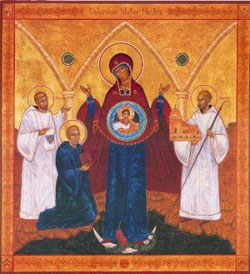
Feastday: April 29
Birth: 1029
Death: 1111
Benedictine abbot and reformer and the founder of the abbey of Citeaux, France, which became the motherhouse of the great monastic order of the Cistercians. A native of Troyes, he was born to noble parents in Champagne. At the age of fifteen, he entered the Benedictine Abbey of Moutier la Celle, near Troyes, where he became prior and abbot of Saint Michael de Tonnere in 1068. He attempted to introduce extensive reforms to the community but met with such resistance that he retired in 1071 and returned to Moutier la Celle. Soon after, a group of hermits in the forest of Collan petitioned Robert to become their head. At first he declined, but the monks persevered and, after winning papal approval for their community, they convinced Robert to accept. In 1074, Robert moved the hermits into the monastery he established at Molesmes. Within a few years, Molesmes grew in size and wealth, and with the prosperity came laxity of discipline. Robert tried without success to resist, and so resigned, going to the hermitage at Or. Though recalled, he remained only until 1098 when he stepped down once more in the face of obdurate resistance by the monks to reinstate full monastic rigor. After winning permission, Robert left with twenty one monks and founded a new community at Citeaux on March 21, 1098. Called by Robert the Novum Monasterium, Citeaux was established with the invaluable aid of Eudes II, duke of Burgundy, and soon acquired much fame for the depth of its spirituality. Much chastened, the monks of Molesmes petitioned to have Robert returned to them. As its abbot once more, Robert turned Molesmes into a leading center for reform, while Citeaux became the heart of the Cistercian order. Robert died as abbot of Molesmes; this was soon extended to the Universal Chruch.
French saintRobert of Molesme (1028 – 17 April 1111) was an abbot, one of the founders of the Cistercian Order and is honored as a Christian saint.
Life
Robert was born about 1029, a nobleman from Champagne, a younger son, who entered the Benedictine abbey of Montier-la-Celle near Troyes at age fifteen and rose to the office of prior.
He was made the abbot of Saint Michel-de-Tonnerre around the year 1070, but he soon discovered that the monks were quarrelsome and disobedient, so he returned to Montier-la-Celle.
Meanwhile, two hermits from a group of monks that had settled at Collan went to Rome and asked Pope Gregory VII to give them Robert as their superior. The pope granted their request, and as of 1074 Robert served as their leader. Soon after, Robert moved the small community to Molesme in the valley of Langres in Burgundy. Initially, the establishment consisted of only huts made of branches surrounding a chapel in the forest, dedicated to the Holy Trinity. Molesme Abbey quickly became known for its piety and sanctity, and Robert's reputation as a saintly man grew. It is because of this reputation that in 1082 Bruno of Cologne came to Robert seeking advice. He lived with Robert's community for a time before going on to found the Grande Chartreuse, the first Carthusian monastery.
In 1098 there were 35 dependent priories of Molesme, and other annexes and some priories of nuns. Donors from the surrounding area vied with one another in helping the monks; soon they had more than they needed, slackened their way of life and became tepid. Benefactors sent their children to the abbey for education and other non-monastic activities began to dominate daily life. The vast land holdings they had acquired required a large number of employees. As the community grew increasingly wealthy, it began to attract men seeking entry for the wrong reasons. They caused a division among the brothers, challenging Robert's severity. Robert twice tried to leave Molesme but was ordered back by the Pope.
Cîteaux
 Modern icon of the founders of Citeaux Abbey: Saints Robert, Alberic and Stephen Harding venerate the Blessed Virgin Mary
Modern icon of the founders of Citeaux Abbey: Saints Robert, Alberic and Stephen Harding venerate the Blessed Virgin Mary
In 1098, Robert and twenty-one of his monks left Molesme with the intention of never returning. Renaud, the viscount of Beaune, gave this group a desolate valley in a deep forest; there they founded Cîteaux Abbey. Stephen Harding and Alberic – two of Robert's monks from Molesme – were pivotal in founding the new house. The archbishop of Lyons, being persuaded that they could not subsist there without the endorsement of an influential churchman, wrote in their favour to Eudo, duke of Burgundy. Eudo paid for the construction they had begun, helped the monks finance their operating expenses and gave them much land and cattle. The bishop of Challons elevated the new monastery to the canonical status of an abbey.
In 1099, the monks of Molesme asked Robert to return and agreed to submit entirely to his interpretation of the Rule of St. Benedict; the local bishop also pressured Robert to return. He agreed and Molesme became a major center for the Benedictines under his tutelage. Albéric was made successor abbot at Cîteaux, with Stephen Harding as prior.
Robert died on 17 April 1111. Pope Honorius III canonized him in 1222. His feast day in the Roman Catholic Church was at first observed on 17 April, later transferred to April 29, and finally combined with the feast of Alberic and Stephen Harding and is observed in our day on 26 January.
The Vie de saint Robert de Molesme was written by Guy, his immediate successor as abbot of Molesme.

